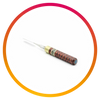How to Make CBD Rosin
In 2018, the Farm Bill more or less legalized hemp across the entire US, and since then, an explosion of hemp flower cultivation has resulted in some impressive looking CBD nugs. In fact, modern cannabis cultivation practices have elevated hemp flower to such a level that it can now be pressed into solventless CBD rosin, and that’s great news for medicinal cannabis users nationwide.
Here we’ll take a look at the unique aspects of pressing hemp flower, the important differences from standard cannabis rosin making, and what to expect from the process. But first, we need to clear something up.
CBD Hemp Flower: Murky Legality
Unfortunately, the 2018 Farm Bill legalized hemp flower in a very narrow way. Essentially, cannabis flower that contains less than 0.3 percent THC is legal for cultivation, sale, purchase, transport, possession, and use in all 50 states… But only as a cosmetic additive. Believe it or not, it’s still considered federally illegal to sell hemp products intended for human consumption.
The situation is made all the more confusing by the fact that the FDA doesn’t appear to be enforcing that legal distinction, and that’s allowed cultivators carte blanche to sell hemp flower on the open market. For residents of legal cannabis states that’s likely not an issue, as your state's laws probably protect you, but for those living in more conservative areas and are ordering CBD hemp flower, your local law enforcement may see things a little differently. So, be careful because hemp flower is not as universally legal as those selling it would have you believe.
CBD Rosin: Starting Material
The great thing about pressing CBD hemp flower is that there are no fundamental differences to pressing high grade THC cannabis, and you can rely on all your existing rosin skills and equipment to get the job done.
As ever, the first step to creating top flight rosin is selecting quality trichome rich starting material, because the more resinous trichomes there are, the more rosin you can squeeze out the other end. So, always look for maximum trichome quantity and quality, as this tends to lead to a more successful pressing.

Additionally, relative humidity plays just as important a role in CBD hemp pressing as it does with standard flower rosin, so ensure your starting material’s relative humidity is in the sweet spot between 55 and 62 percent. Boveda humidity packs prove as useful as ever in this regard.
Solventless CBD Rosin: Lower Yields
Unfortunately though, no matter how well CBD hemp flower has been cultivated, it just doesn't possess the same quantity of resin as your typical cannabis flower. It’s therefore important to be aware that your overall yield will be noticeably lower than when pressing with standard high grade, and a 15% return is about as good as it gets currently.
The Difference When Pressing Hemp Flower
When it comes to pressing hemp flower all your standard rosin practices apply, from pre-molding, to micron filtering, and parchment paper. Nevertheless, there is one noticeable difference, and that’s the need for higher plate temperatures. The general consensus among CBD rosin makers is that hemp flower requires a little extra grunt, and that would make sense as CBD does have a higher melting point than THC.
As a jumping off point we'd recommend pressing hemp flower at 220 degrees F for 3 minutes, and adjusting from there. However, pressing CBD flower tends to produce a dark, toasty, and low yielding rosin regardless of settings, and wouldn’t be our recommended method for making CBD rosin.
CBD Hash Rosin: The Way to Go
If you’re serious about making solventless CBD rosin, then we would first recommend extracting the hemp flowers trichomes with the use of dry-sift tumblers, and making CBD hash. Pressing from hash improves rosin’s yield and quality enormously, and in this situation has one particularly useful benefit.

Pressing pure trichomes allows you to use significantly lower plate temperatures than with flower, and that makes a huge difference with CBD rosin. By pressing CBD hash, you can get down to 180 F, and that will allow you to avoid that dark toasty final product that hemp flower rosin produces. Furthermore, the boost in yields from a hash press makes the whole CBD rosin process far more worthwhile, and results in a significantly more pleasant dab.






















Comments
Leave a comment